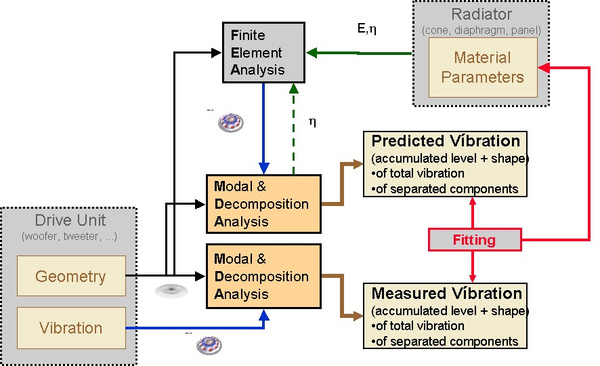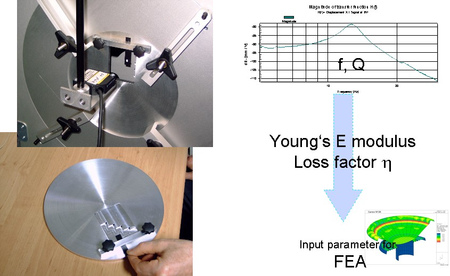Material Parameters of Loudspeaker Parts
Characteristics: | KLIPPEL R&D System |
|---|---|
| Young's E modulus | MPM |
| Modal loss factor η | MPM, SCN, HMA |
Finite element analysis (FEA) requires the properties of the materials in transducers, such as paper, rubber, plastic, fabric, metals and any compound materials. The Young’s E modulus and the loss factor η of the raw material can be measured by using a modified vibration beam technique (according ASTM E 756-93) which can be applied to soft materials, such as thin foils of plastic, rubber and any kind of paper and impregnated fabric. Samples taken from spherical cones or surround roles are problematic because the curvature in the beam makes the beam stiffer causing higher values of the measured E modulus.
Alternatively, the material parameters can be identified by fitting the results of the predicted vibration of a loudspeaker part using an FEA to the results of a mechanical laser scanning measurement applied to a prototype.
Module | Comment |
|---|---|
| Material Parameter Measurement (MPM) | MPM measures the Young’s E modulus and the loss factor η of plane material samples dynamically by using vibration beam technique. The parameters are measured at low frequencies (< 100 Hz) and should be used in FEA at those frequencies. However, the simple technique is useful for checking the consistency of the material properties and simplify the communication between manufacturer of drive units and soft parts. |
The modal analysis supported by SCN gives the natural frequencies and modal loss factors of parts with the shape as used in the final application. The Young’s E modulus can be found by fitting the natural frequencies predicted by finite element modeling to the measured ones. This method gives most reliable results and shows the dependency of the parameters over frequency in the audio band. | |
| Higher Modal Analysis (HMA) | Uses laser scanner measurement for automatic identification of modal parameters (modal resonance frequency, damping, gain) and characteristic vibration patterns (mode shapes). This divides the complicated vibration pattern on the diaphragm into separate vibration components that are easier to interpret. Modal parameters can be used to tune finite element models which share the same “modal view”. The module provides animated view of diaphragm deformation to locate potential sources of nonlinear distortion. |
Examples:
Standards
American Society for Testing and Materials
ASTM E111-04 Standard Test Method for Young's Modulus, Tangent Modulus, and Chord Modulus
ASTM E756 Standard Test Method for Measuring Vibration-Damping Properties of Materials
Other Related Tests
Typical Test Objects
Papers and Preprints
W. Klippel, et al., “Distributed Mechanical Parameters of Loudspeakers Part 1: Measurement,” J. of Audio Eng. Soc. 57, No. 9, pp. 500-511 (2009 Sept.).
W. Klippel, et al., “Distributed Mechanical Parameters of Loudspeakers Part 2: Diagnostics,” J. of Audio Eng. Soc. 57, No. 9, pp. 696-708 (2009 Sept.).
F. J. M. Frankort, “Vibration Patterns and Radiation Behavior of Loudspeaker Cones,” J. of Audio Eng. Soc., Volume 26, No. 9, pp. 609-622 (September 1978).
A. J. M. Kaizer, “Theory and Numerical Calculation of the Vibration and Sound Radiation of Cone and Dome Loudspeakers with Non-Rigid Diaphragms,” presented at the 62nd Convention of the Audio Eng. Soc., March 1979, Preprint 1437.
A. Chaigne, et al., “On the Influence of the Geometry on Radiation Electrodynamic Loudspeakers,” presented at the 120th Convention of the Audio Eng. Soc., (May 2006), Preprint 6775.
P. J. Anthony, et al., “Finite-Element Analysis in the Design of High-Quality Loudspeakers,” presented at the 108th Convention of the Audio Eng. Soc., February 2000, Preprint 5162.
J. Wright, “Finite Element Analysis as a Loudspeaker Design Tool,” Paper MAL-11; Conference: AES UK Conference: Microphones & Loudspeakers, The Ins & Outs of Audio (MAL); March 1998.


